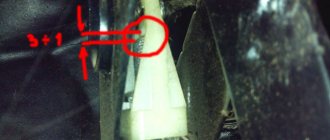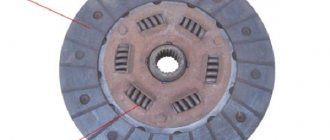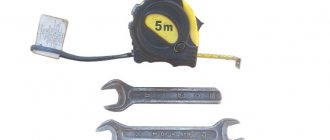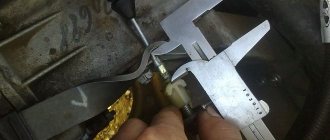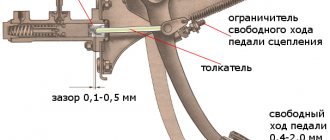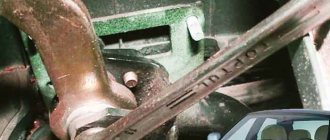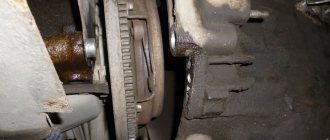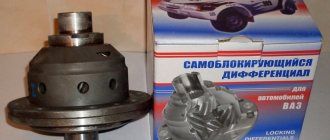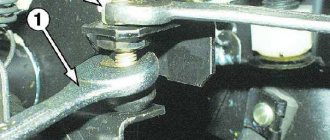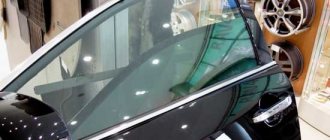And so, it’s time to write something in the magazine. I’ve already done quite a lot from my wish list, and I continue to do so, taking photographs along the way, but I don’t have enough time for decoration. I will catch up as best I can in chronological order. In general, after I took Kalina from the previous owner, I was a little infuriated by the fact that when I pressed the clutch, a characteristic “click” was heard. I came to see what was there, and there, as many people know, is the so-called clutch cable tensioner mechanism. In addition, it was still difficult to engage 1st and 2nd gears. Further in the “Murzilka” on Kalina, in the section about replacing the clutch cable, I read the part about adjusting the initial position of the cable.
Well, I replaced the cabin and air filters in one go. The air was basically more or less normal, it was supposedly changed about 5 thousand ago, but the interior one was crap. Plus, when I pulled out the interior one, it turned out that one leaf somehow ended up under it, and I clearly heard the rustling of this leaf when the heater was turned on. Now everything is fine
Many owners of Lada Granta, Kalina and Priora notice the creaking of the clutch pedal. Moreover, this problem may arise after the first kilometers of driving. We will tell you about the possible causes of this disease, as well as ways to solve it.
First, make sure your car's clutch is adjusted correctly. While holding the clutch cable end in an extended position, measure the size between the fork and the driver, it should be 27 mm. How to adjust the clutch cable is shown in the video:
About 11% claim that the cause of clutch squeaking was the clutch cable. Pay attention to the presence of a spring in the tension mechanism; Lada Kalina 2 and Lada Granta may not have it. It is worth noting that this spring is present on the clutch cable of the Lada Priora and the owners of these cars practically do not encounter a squeaking clutch pedal. If there is no spring, then it should be installed. Also, it would be a good idea to lubricate the clutch cable using a thin tube, or, if suitable, install a clutch cable from Lada Priora (catalog number: 21700-1602210).
Clutch pedal on grant creaking, clicking, adjustment
About the clutch pedal on the Lada Granta
Such a unit on any car is a transmission element, with the help of which, when the pedal is pressed, the transmission of torque from the engine to the gearbox, and then to the drive wheels, is interrupted. With its help, it is possible to smoothly start from a place after parking the car, or change gears while driving. On the Lada Granta, the clutch is installed from its predecessor, the Lada Kalina.
This transmission unit has a traditional, backlash-free classical design. This indicates that there is no play between the pressure spring and the bearing that releases the clutch. It is driven by pressing the pedal using a cable. This unit consists of a flywheel on which the basket is attached. It provides constant pressure on the pressure plate to transmit torque from the engine. This unit, like all mechanisms, sometimes requires adjustments and repairs. Let's talk about how the adjustment is performed in more detail.
Adjustment work
On this car, the drive is carried out using a cable that has an automatic tension system, or, as it is also called, a wear compensator. If everything is done and the adjustment is carried out correctly, then the owner of the car during operation does not need to adjust the gaps or make adjustments to the release pedal.
Be that as it may, problems still happen sometimes. A variety of reasons contribute to this. Various noises may appear during operation, the clutch clicks, the pedal creaks. There may be other unusual manifestations while driving the Lada Granta.
The correct gap is considered to be the case when its value between the power fork and the wing is 27 millimeters.
This is followed by mandatory lubrication of all elements in the pedal assembly. At the same time, we must not forget about the plastic of the compensator ratchet, clutch bushing, and the casing of its drive cable.
When this adjustment is made, there is usually no more clicking in the drive, and the pedal does not make unpleasant sounds.
Sometimes a squeaking sound can come from the engine compartment of a car. Its source may be the tip lead. To eliminate this squeak, it is enough to lubricate the contact point between the plastic nut and the clutch release fork.
In some cases, the cause of squeaks from the engine compartment may be a lack of lubrication on the gearbox input shaft. In such cases, graphite lubricant in a can comes to the rescue. To eliminate this malfunction, remove the engine protection and lubricate the rubbing parts.
When the source of extraneous noise is the clutch release cable, you should also try to lubricate it with graphite lubricant. Insert the canister tube between the cable and the casing and try to lubricate it. In cases where this does not help, change the drive cable.
If, after all the adjustment work, you still hear extraneous sounds from the clutch side, something clicks there and the pedal creaks. Then you need to contact a car service for a more complete check of this unit.
Clutch replacement work
Check the wear of the friction linings of the pressure plate. If wear exceeds the permissible limit, it is replaced with a new one.
Installation on the flywheel is carried out in the reverse order.
How to choose the best wheels with a diameter of 16 inches
Let's calculate what the outer diameter of tires of the following standard size is: 195/45 R16. The resulting value is 582 mm. Which is 2 mm less than the outer diameter of the tires installed by AvtoVAZ itself. And the rim of an alloy wheel with an increased diameter should not be narrower than 7 inches (7Jx16 wheels are needed). It is interesting that the only configuration of the Kalina-2 Sport uses tires of size 195/50 R16, but we are going to install lower-profile tires.
Various Kalina-2 hatchbacks with 16-inch wheels
Now, let's talk about the meaning of departure. It is clear that it should be from the range ET-35 - ET-38. When using a larger value, we eliminate the possibility of rubber “catching” metal, but we add load to the chassis. In general, wheels with an offset of ET-38 can be installed if the warranty is not needed. The value recommended by AvtoVAZ, ET-35, is suitable: many owners of VAZ cars purchase 7Jx16 ET-35 wheels, if we talk specifically about 16 inches. On such wheels they mount tires 205 mm wide and 92 mm high, and somehow the whole thing rides. Our conclusions:
- 205/45 R16 – not recommended, but viable;
- 195/45 R16 is quite suitable.
Note that the conclusions refer to the option of using disks of the following standard size: 7Jx16 ET-35.
In conclusion, just in case, we will list which discs are installed on the Kalina-2 from the factory. If we are talking about casting and a diameter of 15 inches, the width of the rim can only be 6 inches (no less). Another option used is 5.5Jx14. This information must be taken into account when choosing - you cannot buy narrow alloy wheels with a large diameter.
The mounting holes for some disks are located on a circle with a diameter of 100 mm. We need 98 mm, but we won’t be able to distinguish one from the other by eye. Therefore, when making a choice, be careful. It is unnecessary to remind you that installing disks with an incorrectly selected PCD parameter value is prohibited. Happy tuning!
Reading time: 7 minutes
Lada Kalina is the first car of the Russian concern AvtoVAZ, produced in 2 generations over 14 years, from 2004 to 2022, and had an appearance close to Western competitors in this class of compact cars. In terms of the cost of the basic equipment, Kalina was always ahead of its European competitors. The high reliability of this Lada made it possible to operate it for 8-10 years, which led to the need to replace worn parts, and the main ones were always the wheels.
Clutch adjustment on Lada Kalina
The first Lada Kalina car was produced by AvtoVAZ in 2004. The car has a number of shortcomings, one of which is the gearbox clutch. Without waiting for a breakdown, I advise you to adjust the clutch. We will tell you below how to adjust the clutch of the Lada Kalina with your own hands.
Clutch design Lada Kalina
Single-disk - refers to the dry type, has a central pressure spring. The pedal and clutch disc are connected by a cable. For this purpose, a special ratchet mechanism is used, which automatically adjusts the length of the rope.
Time leaves its mark on everything, including the linings of the driven disk - they wear off and become thinner. The ratchet mechanism compensates for this wear by tensioning the cable. This happens by turning the shutdown fork, which causes the spring located in the bushing of the adjustment mechanism to compress. Ta, in turn, presses the clamps of the toothed tip of the cable. The tip is released and the cable is tensioned.
The purpose of the ratchet mechanism is to make life easier for the owners. It relieves them of the need to spend time and effort on self-adjustment. But this is in theory. Practice has shown that it is not possible to operate a car without adjusting the clutch.
When to adjust the clutch Warning :
Inspection and adjustment work must be carried out with the engine turned off.
1. Press the pedal several times in a row and listen for any extraneous noise (clicks, creaks, etc.). Pay attention to how the pedal moves: whether it sticks or not.
If you cannot determine by eye whether it returns to its place freely, but you have suspicions, then do the following: - press the clutch all the way by hand; - release, but Your hand should be on the pedal to feel its progress, but not interfere with it.
If it sticks or returns to place with characteristic jerking, then it is necessary to adjust the clutch on the Lada Kalina.
2. Take a ruler and measure the distance from the floor to the outer part of the pedal. Press the pedal until it hits the floor. Release and remove the size again: if the distance is more than 14.6 cm. then the pedal travel needs to be adjusted to the standards.
3. Parameters, deviation from which requires adjustment: - full pedal stroke - 14.6 cm. (possibly less, but not more than the specified value); - the lower guide of the cable can move relative to the release fork lever by a maximum of 2.7 cm; - beating of the linings home disk - no more than 0.5 mm; - the distance between the working surfaces of the linings and the rivets that hold – 0.2 mm. (less is unacceptable). Do-it-yourself clutch adjustment for Lada Kalina
1. Remove the air filter.
2. Pull the tip to give the cable maximum tension.
3. Take a caliper and measure the distance between the leader and the fork lever. If the distance does not correspond to the recommended above 2.7 cm. use a leash to straighten the dimensions. To do this, rotate it along the thread of the tip.
4. After setting the dimensions, press the clutch several times and take new measurements. If you are confused, please correct it again. And so on until you achieve the desired results.
The clutch of the Lada Kalina car has the ability to fail at critical moments. But, as you can see, the simplicity of its adjustment becomes a balm for the soul. I also advise you to familiarize yourself with another problem with the car - the steering rack. We talked in detail about how to carry out repairs yourself.
Source
Principles of clutch adjustment on Kalina
Popular domestic model
Lada Kalina is very popular among Russian car enthusiasts, but most of its owners note that the model has a number of significant shortcomings. In particular, criticism is caused by the appearance, comfort and technical equipment of the machine.
Many complaints have been made regarding how the Lada Kalina clutch works. Although, reading the instructions for this vehicle, it is difficult to believe that any malfunctions could occur when the clutch operates.
Clutch device
The clutch of this model from AvtoVAZ is single-disk and belongs to the dry subtype. It is equipped with a pressure spring located in the center. The pedal is connected to the clutch disc using a special cable, the length of which is adjusted by a ratchet mechanism. This can be seen if you watch a video demonstrating the design of Kalina.
The lining of the dependent disc wears off and becomes thinner during use. The malfunction is eliminated using a ratcheting mechanism, which compensates for wear by tensioning the cable. The tension causes the release fork to rotate and compress the spring, which is located in the bushing of the control mechanism. The spring, in turn, compresses the clamps located on the toothed tip of the cable. As a result of all these manipulations, the tip is released and the cable is tensioned.
The ratcheting mechanism eliminates the need for car owners to waste time and effort on adjustments. But this is only in the theory developed by Kalina's designers. In reality, when operating a car, you need to know how to adjust the clutch yourself.
When adjustment is required
Clutch adjustment
Clutch adjustment is only performed when the engine is switched off. It is required if there is a deviation from the following values:
- full pedal travel does not exceed 146 mm;
- movement of the cable lead relative to the release fork lever - within 270 mm;
- runout of the dependent disc linings does not exceed 0.5 mm;
- the distance between the pads and the rivets that hold them is 0.2 mm or less.
There are several ways to check if your car needs a clutch adjustment.
- You should press the pedal several times in a row and listen for any extraneous noise. If the clutch pedal sticks or squeaks, it is advisable to make an adjustment. In some cases, car owners are unable to visually assess whether the pedal returns to its place freely. In such situations, it is recommended to do the following:
- press the clutch with your hand until it stops;
stop applying force, but leave your hand on the pedal in order to feel if there is movement.
If the clutch pedal sticks and clicks, or it returns to its original position with characteristic jerking, you need to adjust the clutch.
It is necessary to measure the distance from the floor to the outer part of the pedal using a ruler or caliper. Then press the pedal until it hits the floor. After this, you need to release the pedal and take measurements again. If the distance exceeds 146mm, be sure to adjust the clutch.
The procedure for adjusting the clutch on Kalina
Owners of Lada cars who have discovered faults in their vehicles are interested in how to adjust the clutch. To do this you need to perform a number of steps.
- Pull the cable forward until it stops at the threaded end. In this case, it is necessary to overcome the resistance of the spring attached to the clutch pedal.
- While holding the cable, use a caliper to measure the distance from the plastic leash to the clutch release fork lever.
- By rotating the leash, bring the distance to the required values. Make sure that when releasing the cable, the leash fits tightly to the fork lever.
- Press the clutch pedal three times to activate the automatic cable length adjustment system.
- Check the full pedal travel.
Adjusting the clutch on a Kalina car is a procedure that every owner of this car must master. By performing timely adjustments, you can significantly extend the life of your vehicle.
expertVAZ.ru
17" casting machine
See what the Kalina-2 hatchback might look like on 17-inch wheels:
Kalina-2 on 17-inch casting, with and without lowering
There are two tuning options presented here, with and without lowering, and in both cases the wheels used are: 7Jx17 ET-38. Tires – 205/40 R17. According to the author of the first method, there are no problems as a result. That is, the wheels do not cling to the body anywhere even when the car is loaded. The only thing is that when you turn the steering wheel all the way, one of the wheels still slightly touches the metal, but this can be neglected.
You need to take into account the following: if you simply take and install wheels with 205/40 R17 tires, the seating position of the Kalina-2 hatchback or station wagon will increase to 175 mm (the standard value is 160 mm). In general, the next step should be a competently executed understatement. Author's version: the front suspension uses struts and springs shortened by 90 mm, the rear suspension is also equipped with shortened shock absorbers and springs (–90 mm). You don’t have to lower anything, but simply install new wheels, and this tuning method has been tested by owners in reality. But it is unlikely that a car with a seat height increased to 175 mm has better handling than the factory version. We will leave the choice to the owner.
Setting up the clutch mechanism on Lada Kalina at home
Like all “basins”, Kalina is not at all flawless. Over its more than ten-year history, the model has been refined more than once, but it has not been possible to get rid of some problems. Among the “Kalinovodov” it is recognized that the torque transmission mechanism, due to its design features, is the weak link of the car. Despite all the modernization in this area, car enthusiasts have to periodically adjust the clutch.
Features of the VAZ 2112 clutch
The machine is equipped with a dry-type single-plate friction clutch with a central pressure spring. Before adjusting the clutch on Kalina, any motorist must take into account that the control pedal is connected to the disc via a cable with a special ratcheting mechanism.
How does automatic cable tightening work?
As a result of intensive use, the friction linings of the disc gradually wear out. The ratcheting mechanism built into the drive design allows you to compensate for wear for a certain period of time - it gradually tightens the cable. During operation of the device, the fork rotates and the bushing spring is gradually compressed. As a result, the cable end clamps are compressed, after which the latter is released and tensions the cable.
The purpose of this design is to facilitate the maintenance process. According to the plans of VAZ engineers, the mechanism should save the owner from the need to make adjustments himself. But this is all only in theory, but in practice it turns out that you cannot do without adjusting the clutch.
When should adjustments be made?
Before adjusting the clutch on a Kalina car, you need to determine the moment when the automatic cable locking no longer functions. This is not difficult, especially since the machine itself signals problems:
- Loss of traction, friction clutch does not provide a reliable connection between the flywheel and the disk. The consequence of such a defect will be the loss of a significant part of the torque force.
- The clutch control pedal does not return to its initial position, which, in fact, is a consequence of the first point.
- Poor clutch disengagement - the pedal is not pressed all the way, which makes changing gears difficult.
The symptoms, however, are similar to those when clutch adjustment is needed on a VAZ 2107, so experienced motorists can skip this unit and proceed directly to the test.
How to check the clutch?
To make sure that the mechanism needs to be adjusted, you should perform a number of basic checks:
- Press the pedal several times and release - any extraneous sounds are unacceptable. For better control, you can press with your hand, this way you can feel the pedal stroke more fully.
- Check the pedal for sticking; if it returns with noticeable twitching, then adjustment is necessary.
- Check the full travel of the pedal using a ruler or tape measure. Press and release the pedal several times, then measure the distance of its outer edge to the floor; if it is more than 146 mm, then the mechanism needs to be adjusted.
- Check the movement of the cable guide relative to the clutch release fork; the maximum distance between these elements is 27 mm.
- If the runout of the driven disk linings is more than 0.5 mm, adjustment is also required.
When performing checks, it is important that the car engine is turned off. You need to start working no earlier than the engine has completely cooled down.
The setup method is simple and does not require a visit to a car service center, because you can do everything yourself. The step-by-step scheme for completing the work is as follows:
You should start working no earlier than the engine has completely cooled down. The setup method is simple and does not require a visit to a car service center, because you can do everything yourself. The step-by-step scheme for completing the work is as follows:
- Before adjusting the clutch drive on Kalina, you should open the engine compartment hood and remove the air filter.
- Visually assess the condition of the cable casing and replace it if damaged.
- Pull the tip toward you until the cable is fully tensioned. After this, check the distance between the fork and the leash with a caliper.
- If the measurements show more than 27 mm, then the distance is corrected by rotating the leader along the thread of the tip.
- Press and release the clutch pedal several times and repeat the measurements.
- If necessary, repeat the adjustment until the required standards are achieved.
The technology for setting up the clutch on Kalina is not as complicated as installing the VAZ 2110 clutch, therefore it is quite feasible in a garage environment without the involvement of specialists. And this fact pleases domestic motorists, because the clutch plays an important role in driving a car.
What disks are suitable as an alternative to the standard versions?
It's time to change the “original” wheels. The main thing here is not to overdo it, but to choose products that are as similar in design and geometric aspects as possible to the standard options. Note that the wheel parameters “don’t care” what body is in front of them (sedan or etc.).
To make the right selection, you will need to gain valuable knowledge such as:
- the quantitative composition of the holes for the mounting bolts and the diameter of the circle, the conditional line of which passes through the centers of the indicated holes (“LZ*PCD”, for Kalina - “4*98”);
- diameter of the central hole of the disk (“DIA”); for disks of this model it is equal to 58.6 mm (coincident with the hub diameter with tolerance);
- the offset value (or “ET”), which varies in values (to be specified later).
Let's summarize here.
1. The first generation of LADA Kalina in versions “1117”, “1118” and “1119” can be equipped with wheel versions from 13 to 16 inches with the following parameters:
- bolt pattern - 4*98;
- width – from 5 to 6.5 (inches);
- departure – from 25 to 35.
2. The second generation “2192” and “2194” will be content with wheels from 14 to 16 inches with the following characteristics:
- “LZ*PCD” similar parameter (4*98);
- width – from 5.5 to 6.5;
- offset: 25 – 35;
- the hole diameter is identical at 58.6 mm.
It should be remembered that correctly selected wheels will allow you to achieve traffic safety, moderate fuel consumption, and also increase the service life of the suspension.
Replacing the clutch cable
In the cabin under the instrument panel..
. Using an “8” wrench, unscrew the nut securing the cable sheath bracket to the pedal assembly bracket.
Use a slotted screwdriver to pry up the spring clip. . and remove it from the groove of the clutch pedal finger.
Remove the eye of the housing of the automatic cable length adjustment mechanism from the clutch pedal pin.
We remove the upper part of the cable from the pedal assembly bracket. In the engine compartment.
. Pull the cable forward and remove the cable guide from the groove of the clutch release fork lever.
Rotating counterclockwise, unscrew the leash from the threaded end of the cable.
Remove the rubber protective cover from the cable end.
We remove the end of the cable sheath from the hole in the bracket on the gearbox. In the cabin, remove the cable sealing cover from the hole in the front panel.
. and pull the cable into the cabin. Before installing the cable...
. check the condition of the plastic bushing on the pedal pin. We replace the worn bushing with a new one and apply grease to the pin. We install the cable in the following sequence: – thread the cable through the hole in the front panel from the passenger compartment into the engine compartment; – install the sealing cover into the hole in the front panel; – put the automatic cable length adjustment mechanism on the pedal pin and secure it; – screw a plastic leash onto the threaded end of the cable so that the end of the cable tip is flush with the end of the leash; – insert the leash into the groove of the clutch release fork lever; – adjust the clutch drive. To do this, pull the cable forward by the threaded end until it stops, overcoming the force of the clutch pedal spring, and hold the cable in this position.
Using a caliper, we measure the distance from the end of the plastic leash to the clutch release fork lever, which should be 27 mm. If necessary, rotate the leash to achieve the required distance. When removing the load (releasing the cable), the leash should adhere to the fork lever without play. After this, press the clutch pedal three times to activate the automatic cable length adjustment mechanism. The full pedal travel should not exceed 146 mm.
One of the disadvantages of the Lada Kalina is problems with the clutch. To avoid visiting a car service center and save time and money, you can diagnose the malfunction and adjust the clutch on the Lada Kalina yourself in the garage. The article describes step by step how to adjust the clutch, and also includes a video that demonstrates the entire procedure.
Stamped and cast: which is better?
According to the production method, wheels for LADA Kalina are divided into two global categories: stamped (from steel sheet) and light alloy (forged, cast or combined).
For the first option, manufacturing involves welding individual structural elements of the product. The technology is simple, which has a positive effect on the cost of disks.
Among the advantages of “stampings” we note:
- reliability;
- maintainability (tendency to eliminate bent areas);
- durability.
- it is difficult to perform auto-balancing;
- significant mass of products;
- lack of design possibilities (same type);
- low corrosion resistance.
Now let's touch on light alloy options. Such discs are more progressive products that are made from light metal alloys such as magnesium and aluminum, etc.
When choosing the kit you like, we recommend paying attention to the indication of the primary metal included in the material structure.
If magnesium dominates, then the discs are light in weight, but the strength properties of this option are far from ideal. Aluminum gives the product strength and fluidity. This translates into good resistance to cracking under impact loads. Wheel alignment will also likely be required.
To give preference to any of the above options, we recommend that you undertake an approximate analysis of the condition of the roads on which your LADA Kalina will travel in the future.
- availability of a wide range of models;
- light weight, which has a positive effect on handling and dynamics;
- good dissipation of heat generated by brake units.
Operating principle of the electronic engine control system (ECM)
In a modern car, all process control, except for the rotation of the steering wheel, and even then, is entrusted to the computer, or Electronic Control Unit (ECU). It contains a program with many different tables. In general, the ECU receives data about the state of the car, speed, revolutions, and activated mechanisms from a large number of sensors. Based on the results of these observations, the ECU, using these tables, includes certain ignition modes, fuel supply and other executive functions.
The role of the clutch sensor
It would seem, what does the clutch have to do with it? And here's what it has to do with it. When the clutch engages, the most sensible thing to do is to reduce the engine speed. But not to idle, but according to the speed of the car. This is not always available to the driver, especially a beginner. And here the computer will come to the rescue. Reacting to the signal from the clutch sensor, it can independently adjust the engine speed.
Important! In addition, in accordance with the Priora speed sensor, the ECU can obtain information about the serviceability of the clutch. Summarizing the above, we can say that the presence of a sensor on the clutch allows:
Summarizing the above, we can say that the presence of a sensor on the clutch allows:
- saves fuel;
- make driving easier;
- monitor the serviceability of the coupling;
- increase its service life.
Therefore, its serviceability is an important factor in the Priora control system.
Design and location of the Priora clutch sensor
In principle, this is the simplest switch. In the position when the clutch is disengaged and the pedal is not pressed, the sensor circuit is open. If you press the clutch drive, the limit switch of the sensor closes and the signal “clutch is on” is sent to the ECU.
It is located on the clutch pedal mounting assembly, where the very tip of this pedal is located opposite the sensor end switch.
Solution
In almost all cases, the problem of a squeaking clutch pedal can be eliminated with the help of lubricant. To do this, you need to lubricate all intensively rubbing parts.
Experts recommend using thick grease (CV joint or something like that) as a lubricant. If the car was designed in such a way that it is impossible to get to the pedal elements or spring, do not despair - there is a way out. Use a slotted screwdriver for this. Apply a little lubricant to its metal part, after which you can reach the necessary places with a screwdriver.
There is also a possibility that the squeak does not come from the pedal, but from the clutch fork. During operation, it serves as a place for dirt and used lubricant to accumulate. Because of this, this unpleasant sound appears.
In order to eliminate squeaking in the clutch fork, it must be washed from dirt. Naturally, it is very difficult to reach it, so this must be done through the engine compartment. To clean, you can use carburetor cleaner - it will do the job perfectly. Once you have removed all the accumulated dirt, apply a coat of thick lubricant to the fork.
Other possible squeaks
In addition to the clutch pedal, the reasons for the appearance of squeaks we have already figured out, the reason may lie elsewhere. For example, if the clutch mechanism uses a cable drive, then it is often the cause of unpleasant sounds. If this is the case, simply changing the lubricant will not help solve the problem. To do this, it is necessary to replace the clutch cable.
If you hear a squeak somewhere from the engine, this indicates a faulty release bearing. To fix this problem, you will most likely need to replace the release bearing.
The clutch pedal may make peculiar noises due to the clutch actuator. This is due to the fact that all the work of the clutch is mechanical friction of the working parts. Naturally, the appearance of noise cannot be avoided. In order to get rid of annoying sounds, you will need to periodically lubricate the rubbing parts. Because you will not be able to control a constant level of lubrication - everything is washed off during operation.
There is a more difficult way out of this situation. Using a skilled turner, turn the bushing between the rubbing parts from a softer metal or polycarbonate. In this case, the occurrence of unpleasant sounds will stop, because the friction of different materials will not create such noise as two materials of the same density and structure create.
Many owners of Lada Granta, Kalina and Priora notice the creaking of the clutch pedal. Moreover, this problem may arise after the first kilometers of driving. We will tell you about the possible causes of this disease, as well as ways to solve it.
First, make sure your car's clutch is adjusted correctly. While holding the clutch cable end in an extended position, measure the size between the fork and the driver, it should be 27 mm. How to adjust the clutch cable is shown in the video:
Clutch adjustment on Kalina, design and adjustment
Clutch adjustment on viburnum, design and signs of the need for adjustment, procedure for adjusting the clutch cable.
Undoubtedly, the Lada Kalina is a fairly popular car among domestic car enthusiasts. Moreover, the fact that it has quite a large number of flaws and shortcomings does not at all affect the high popularity of this particular model from the Lada family. The clutch on the viburnum has always been problematic. If you look at the design of the clutch itself, it’s hard to believe that the Lada has problems there and requires fairly frequent adjustment of the clutch on the viburnum.
Clutch design for Lada Kalina
Clutch Lada Kalina
The Lada Kalina is equipped with a dry clutch type, which has a single disc and a central pressure spring. The fret design has a ratcheting mechanism for adjusting the length of the cable. The work process is accompanied by constant wear of the friction linings of the disk, and as a result the cable changes its tension, and here the ratcheting mechanism comes into play, which compensates for this wear. The working process of the ratchet mechanism is as follows:
- The tension of the cable turns the release fork, thereby forcing the spring to compress;
- Compression of the spring causes compression of the clamps, which are located on the toothed tip of the cable;
- The tip is released and the cable is tensioned.
Naturally, this is the theory that was used when designing the Lada Kalina. The reality is somewhat different from the theory; the Viburnum clutch simply forces its owners to sometimes roll up their sleeves and adjust it. Don’t be afraid to do this yourself, because this is a fairly simple procedure, because the Kalina clutch itself is so simple in design that even replacing the unit is not a particularly difficult job.
Signs that your clutch cable needs to be adjusted
It is necessary to adjust the clutch cable after the following symptoms appear:
- Extraneous sounds when disengaging the clutch;
- Problems when shifting gears;
- Poor traction;
- Incomplete release of the clutch.
Adjusting the clutch cable Lada Kalina
You can check the clutch by performing a few simple steps: with the engine turned off, you need to depress the clutch pedal several times, and you should listen carefully to see if there are any extraneous noises during the pressing process.
If during this procedure you hear noises or feel increased play or jamming of the pedal, then most likely it is worth adjusting the cable, but first pay attention to its appearance; if the cable itself is rusty or has tears at the attachment points, then it may be necessary its replacement. However, not all car enthusiasts can easily determine play and jamming by eye.
In such cases, it is best to press not with your foot, but with your hand, because it is a more sensitive human organ
However, not all car enthusiasts can easily determine play and jamming by eye. In such cases, it is best to press not with your foot, but with your hand, because it is a more sensitive human organ.
There is a more effective way to check the clutch of a viburnum. It consists of measuring the pedal stroke, for this you need to:
- Measure the distance using a ruler from the floor to the pedal itself;
- Press the clutch pedal to the floor and measure the distance again;
- Perform the procedure several times for the most accurate result.
Now let’s compare the obtained value with the regulated one, which is 146 mm. If you have more value, then adjustment is simply inevitable.
Characteristics of standard wheels of different configurations
The first generation Kalina models are equipped with 14 and 13 inch products. The light-alloy version was released with a diameter of R14. With this reduced tire profile, it is also possible to install R15 (this was done in the sports version).
For all modifications of the sedan, hatchback, station wagon, and sport models of the first generation, released in 2004–2013, the following dimensions were used:
- 5J wheels on 13 ET40, matching tires - 175/70R13;
- 5.5J on 14 ET37 - 175/65R14;
- 6J on 14 ET37 - 185/60R14;
- 6.5J on 15 ET35 - 195/50R15;
- 6.5J on 16 ET45 - 195/45R16.
All modifications of cars (hatchback, station wagon, cross, sports of the second generation (since 2014) were equipped with the following types of wheels and tires:
- 5.5J on 14 ET35, tires - 175/65R14;
- 6J on 14 ET35 - 185/60R14;
- 6J on 15 ET35 - 185/55R15;
- 6.5J on 15 ET35 - 195/50R15;
- 6.5J on 16 ET35 - 195/45R16.
The “norm” and “standard” packages of the second generation do not have factory alloy wheels. In the luxury package, the buyer can choose cast R14 and R15.
